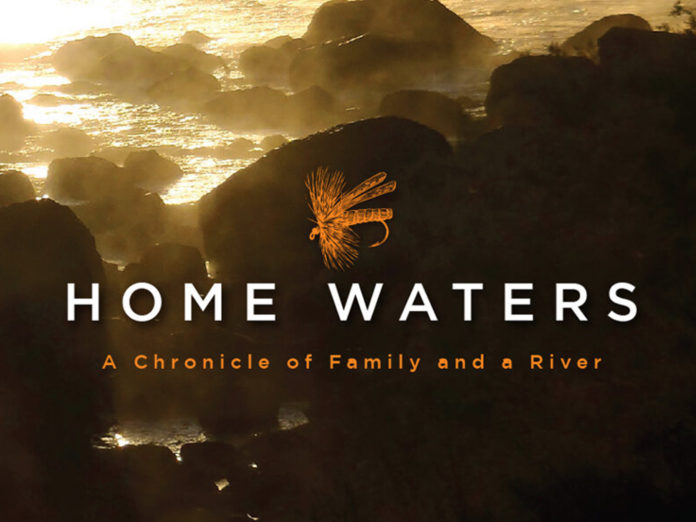“I do not fish alone on the Blackfoot River, ever, even though now I mostly fish it by myself. When I’m on the water, and especially when no one else is around, I feel the presence of the generations of my family whose stories run through it,” writes John N. Maclean in “Home Waters: A Chronicle of Family and a River.” Maclean’s latest book, published by Harper Collins in July 2021, is an intimate collection about one of Montana’s legendary families, made famous by the author’s father, Norman Maclean. Norman Maclean achieved literary fame with the 1976 novella “A River Runs Through It.” The generational presence that Maclean experiences as he fishes the regal Blackfoot River is what flows throughout the slim volume, a compilation of essays intimately exploring how one family became bound to Montana.
Home Waters is the younger Maclean’s sixth book, and his first memoir. He’s written five nonfiction books on wildland fires in the American West and for thirty years was an award winning journalist at the Chicago Tribune. Raised in Chicago, each summer Maclean would return to his family’s Seeley Lake cabin, built by hand by his grandfather, Reverend John Norman Maclean, for his annual summer apprenticeship on fishing. The Maclean family’s ties to Montana began at the end of the nineteenth century when the Reverend and his wife, Clara, moved to Bozeman to serve as minister for the First Prebysterian Church. Their two sons, Norman and Paul, were raised in Missoula. Robert Redford’s 1992 film adaptation of Norman’s bestselling book, starred Brad Pitt as Paul, the gifted fly-fisherman yet troubled young man, depicted a close-knit family where life’s most valuable lessons were taught from the pulpit of the river, where religion and fishing tended to merge into one. It should come as no surprise, then, that fishing is the main line cast in “Home Waters.”
Illustrated wood engravings by the Canadian artist Wesley W. Bates serve as a visual rendering to launch each chapter. The book takes on the kinetic energy of fly fishing. From the book’s opening, we’re plunged alongside Maclean on the famed Muchmore Hole of the Blackfoot, wondering if he’ll catch the fish of a lifetime. We are then cast back into the past, with Maclean sharing family lore of his father’s early life in Montana, a place that was once known for its “aura of a mythological kingdom.” Many today might still claim that aura, one that has endured thanks to the popularity of “A River Runs Through It.”
Just like Maclean works the river, moving downstream, mending his line, Home Waters flows through family history on both his maternal and paternal streams. He dips into deep pools of memory, showing us how “Fishermen know the wonder of being attached to a living but unseen power that lies below the surface. The connection between my family, the Blackfoot River, and Montana has been like that, a tie rooted in memory and rekindled each year.” That unseen power rises to the surface under Maclean’s pen even as he drifts deeper into the past such chapters like “The River of the Road to the Buffalo.” Although many associate the Blackfoot River with fishing and floating, this chapter reminds us that for centuries the river corridor serveda vital purpose for the land’s indigenous inhabitants to cross the Blackfoot Valley and then over the Continental Divide to the buffalo hunting grounds of the Missouri River region. Native tribes called the Blackfoot River Cokahlarishkit, meaning the “the river of the road to the buffalo.” The Cokahlarishkit Trail was a major travel corridor for at least 5,000 years, long traversed by the Kootenai, Salish, Nez Perce, Shoshone, Blackfeet, and Crow tribes. The Lewis and Clark expedition also used the ancient path, and as Maclean observes after hiking to Lewis and Clark Pass, examining the expanse of the valley surrounding him, “It’s a land with a long-term memory.”
It is memory itself that drives Maclean’s narrative. As he writes, “Memory can and should be more than a bridge to the past. It’s also a way to see yourself as a thread in a broad fabric long in the making.” Be it thread or bridge, the insights revealed in these pages push beyond family lineage and into the interconnected web of life and how our relationship to place is a vital current that never ceases. Maclean acknowledges how he sees himself as reflected by those shimmering, sometimes beguiling waters, always peering deeper to understand the “. . . living, physical link binding us together.” You do not have to be a devout angler or have previously read A River Runs Through It to enjoy Home Waters. The book is a testament to the power of place and the love that binds us, throughout the generations. Home Waters is a keeper.
Credit: Source link































